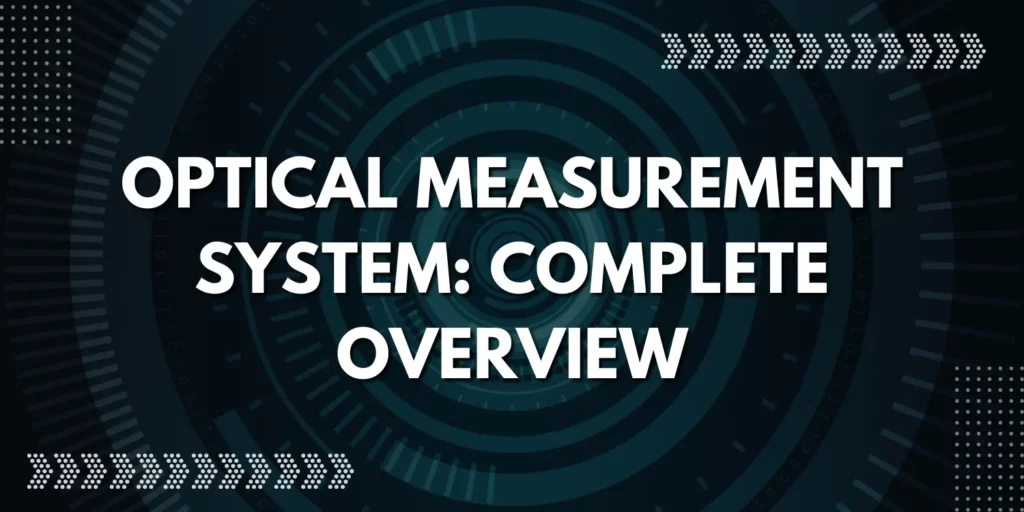Quality control is vital in the modern world of precision manufacturing. Having a technology so precise that it can measure the smallest details with accuracy beyond human capability, it’s the Optical Measurement System, a marvel of scientific ingenuity and engineering excellence.
What is an Optical Measurement System?
An Optical Measurement System, often abbreviated as OMS, is an advanced device used to measure various physical properties of objects using light-based techniques.
Unlike traditional measurement methods that may require physical contact with the object, optical systems offer non-contact measurements to minimize the risk of damage and ensure high accuracy.
What are the components of Optical Measurement Systems
These systems comprise several key components:
- Light Source: Typically lasers or LEDs emitting focused light.
- Optical Components: Lenses, mirrors, and prisms for directing and manipulating light.
- Detectors/Sensors: Devices to capture and convert light signals into measurable data.
- Data Processing Unit: Software and hardware for analyzing captured data.
- Calibration Mechanisms: Ensuring accuracy through periodic calibration against known standards.
Major Types of Optical Measurement Systems
Optical Measuring Systems encompass a diverse range of devices for specific applications and measurement requirements. Here are some common types:
1. Laser-Based Systems:
- Utilizes laser technology for precise distance measurements and 3D scanning.
- Examples include Laser Interferometers and LiDAR (Light Detection and Ranging) systems.
- Widely used in industrial metrology, robotics, and geographic mapping.
2. Imaging Systems:
- Captures detailed images of objects for dimensional analysis and surface inspection.
- Examples include Digital Imaging Correlation (DIC) systems and Optical Microscopes.
- Applied in fields such as materials science, biology, and quality control.
3. Interferometric Systems:
- Employs interference patterns of light waves to make highly accurate measurements.
- Examples include White-Light Interferometer and Fabry-Perot Interferometers.
- Used for surface profilometry, optical testing, and precision engineering.
4. Spectroscopic Systems:
- Analyzes the interaction between light and matter to determine material properties.
- Examples include Raman Spectrometers and Fourier Transform Infrared (FTIR) Spectrometers.
- Commonly employed in chemical analysis, pharmaceuticals, and environmental monitoring.
5. Confocal Systems:
- Uses a pinhole aperture to eliminate out-of-focus light and enables high-resolution imaging.
- Examples include Confocal Laser Scanning Microscopes (CLSM) and Confocal Profilometers.
- Ideal for biological imaging, surface roughness measurement, and semiconductor inspection.
Working Principles of Optical Measurement Systems
Optical Measurement Systems operate on the principles of light interaction with objects:
- Reflection: Light bouncing off the object’s surface, revealing its geometry.
- Refraction: Light bending as it passes through the object, indicating its optical properties.
- Scattering: Light diffusing in different directions, providing information about surface roughness.
- Absorption: Light being absorbed by the object, revealing its material composition.
Applications of Optical Measuring Systems across Various Industries
Optical measurement systems find applications across a wide range of industries due to their versatility, precision, and non-contact nature.
i). Manufacturing: Ensures precise dimensions, detects defects, and aligns components accurately during assembly processes using optical measurement systems.
ii). Automotive: Optics guarantee quality in manufacturing and enable advanced driver assistance systems for safer driving experiences.
iii). Aerospace: Crucial for inspecting aircraft components and guiding missiles, UAVs, and spacecraft with precision optical sensors.
iv). Medical: Optical imaging aids in diagnosis and surgery, while research benefits from studying cellular structures and DNA analysis.
v). Electronics: Inspects PCBs and ensures microelectronics’ precision fabrication with optical systems in the electronics industry.
vi). Semiconductor: Controls lithography processes and inspects wafers for defects, maintaining high standards in semiconductor manufacturing.
Optical Measurement Systems Limitations and Challenges
Despite their precision, OMS face challenges such as:
- Sensitivity to environmental conditions like temperature and vibration.
- Limited depth of field and susceptibility to noise.
- Cost and complexity, requiring skilled personnel for operation and maintenance.
Which is the most advanced OMM- Optical Measurement Machine?
The most advanced Optical Measuring Machine is the VIEW Benchmark™ 300, a high-performance floor model optical metrology system. Engineered with cutting-edge optics, illumination, and image processing, it delivers unparalleled precision and reliability.
Ideal for medium format metrology applications, it ensures high throughput and accuracy, setting a new standard in Optical Measurement Equipment.
Conclusion
Optical Measurement Systems stand as pillars of precision in our technologically-driven world. With their ability to unveil the minutest details with unparalleled accuracy, they play a pivotal role in ensuring quality, innovation, and progress.
Embrace the power of Optical Measurement Systems with VIEW, offering highly precise dimensional metrology and optical Metrology systems for a future of precision without compromise.
